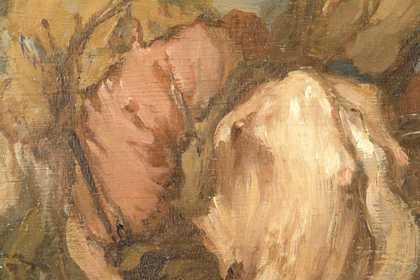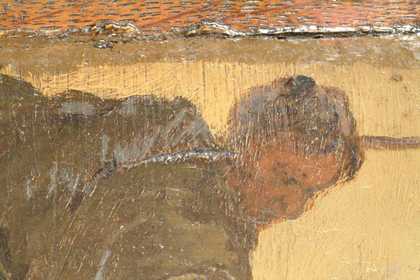
Fig.1
Francis Le Piper ?1640–1695
Hudibras’s First Encounter with the Bear-Baiters
c.1664–77
Oil paint on panel
216 x 425 mm
T00620
This painting is in oil paint on wooden panel measuring 216 x 425mm (fig.1). The panel is a single piece of oak, cut tangentially and with uneven thickness (figs.2–3). It is up to 5 mm thick.
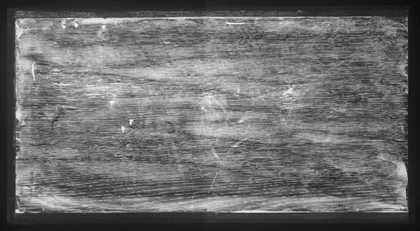
Fig.2
X-radiograph of Hudibras’s First Encounter with the Bear-Baiters c.1664–77
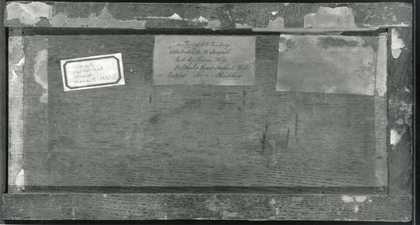
Fig.3
The reverse of Hudibras’s First Encounter with the Bear-Baiters, photographed in black-and-white
The marks left by the tools used to dress the surface are visible on the front of the painting in raking light (fig.4). The grain of the wood runs horizontally. Although 126 growth-rings are present in this piece of oak, it was not possible to assign dates to them; this suggests that the wood is British oak because the established data for dendrochronology comes from trees that grew in the Baltic area.1 ‘L-section’ oak battens (about 30 mm wide and 10 mm deep) are attached with glue to the top, bottom and left edges of the panel, lapping over onto the reverse. Originally there would have been one on the right edge too. The corners of the battens have half-lap joins at the corners. These battens appear to be an original framing device and occur also in the other three panels in this series (The Combat of Hudibras and Cerdon, Tate T00247; Hudibras and Ralph Taken Prisoner, Tate T00248; and Hudibras’s Discomfiture at the Hands of the Skimmington T00621). Owing to its irregular cutting and the presence of the battens, the panel has developed complex warps and has been subject to minor splitting in the past. All the splits have been rejoined and appear stable now.
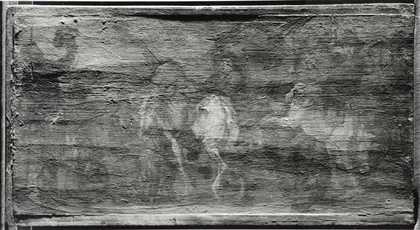
Fig.4
Hudibras’s First Encounter with the Bear-Baiters, photographed in raking light from the top in black and white
The ground is salmon pink colour and extends all over the front of the panel. It is fairly thick (120 microns) and even, and is composed of lead white, red and brown earth pigments, Cologne earth, pipe clay, glassy particles and chalk (figs.5–6).2 Unlike the other three paintings in this series, which are on pink grounds, this painting has a pale grey priming; it is composed of lead white, black, verdigris, earth colours, glassy particles and chalk. It was applied with sweeping, criss-cross brushstrokes whose varying thickness can be discerned through the painted image. Ground and priming are bound in oil.

Fig.5
Cross-section through the hat below the top right corner, photographed at x320 magnification. From the bottom: pink ground; pale grey priming; green foliage paint; dark paint of hat
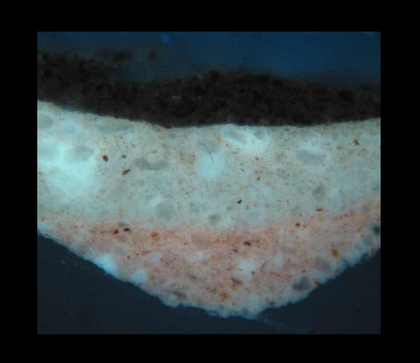
Fig.6
Cross-section through the hat below the top right corner, photographed at x320 magnification in ultraviolet light. From the bottom: pink ground; pale grey priming; green foliage paint; dark paint of hat
No linear underdrawing is visible with the eye or with infrared (fig.7), but certain features were laid in with reddish brown and green paint, which was allowed to dry before the artist proceeded further.
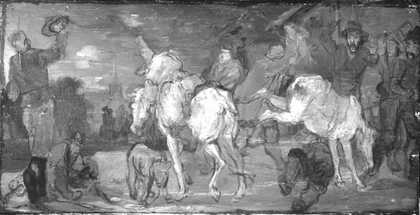
Fig.7
Infrared reflectograph of Hudibras’s First Encounter with the Bear-Baiters
Thereafter the painting appears to have been done in one layer, the colours mixed on the palette and worked into one another wet-in-wet on the prepared surface of the panel with bold, vigorous brushwork and fairly thick, creamy, opaque paint (figs.8–10). Analysis with polarising light microscopy of brown paint from the left background revealed the following pigments: lead white, brown earth colours and Cologne earth.
The painting was cleaned and varnished while on loan to Tate in 1955, and has needed no major treatment since entering the collection in 1963.
November 2003

